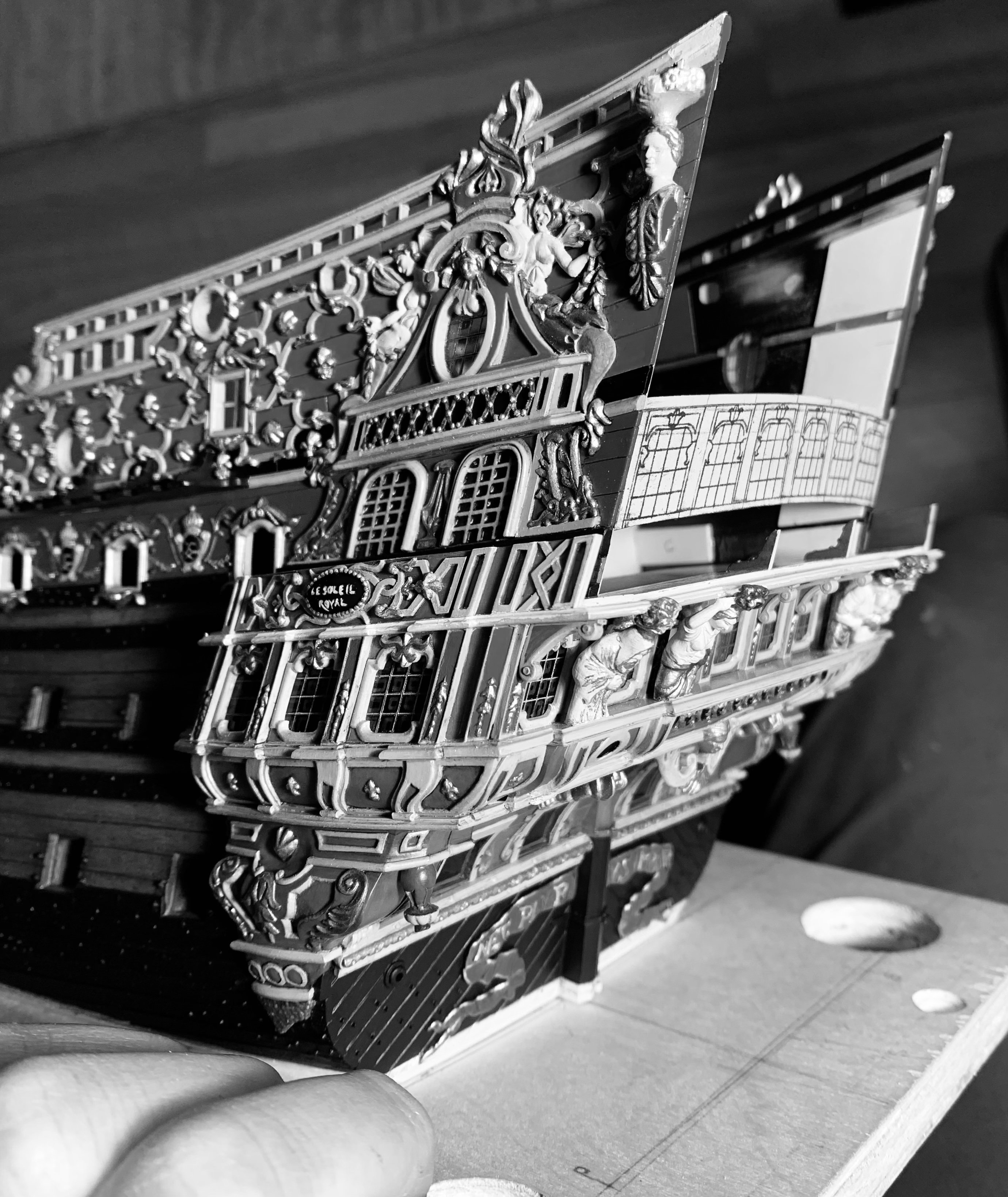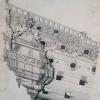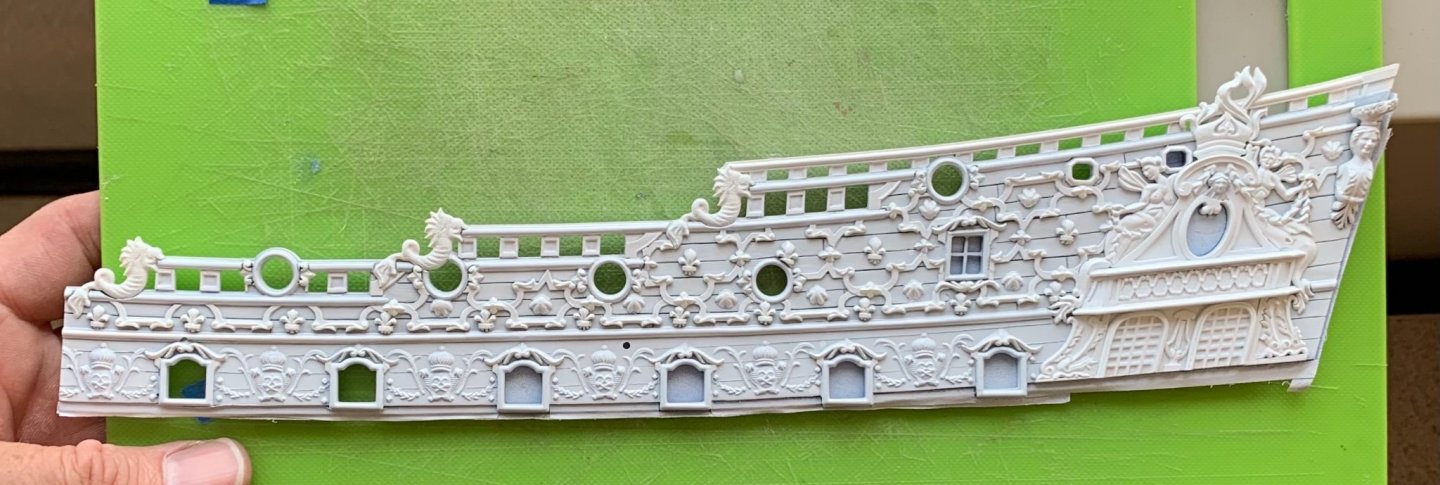-
Posts
3,295 -
Joined
-
Last visited
Content Type
Profiles
Forums
Gallery
Events
Everything posted by Hubac's Historian
-
It is nice to see you again, Marc. Beautiful work on the port framing!
- 208 replies
-
- le soleil royal
- 104 guns
-
(and 2 more)
Tagged with:
-
Thank you for the birthday wishes, Bill, and thank you very much for reading through my log! Over the years, it has grown to an absurd length for the progress made, but the research, therein, is essentially the book I will eventually write, in its unedited long-form. To your question, I would probably display one side with a fully open broadside, and the other side fully closed - if I wanted to show the contrast in appearance. On my first SR, I closed some ports on the lower tier, because I was copying the box cover artwork. As time went by, I came to regard that as a sort of arbitrary display without much logical grounding in what would have really happened on the ship. One other possibility would be to close all of the ports on the lower deck, as would be done if weather conditions would not allow for those guns to be run out.
-
There are quite a number of MSW builders named Mark, who are doing remarkable things, here: Mark Taylor, Mark (SJ Soane), Mark Tiedens, and I am also a Marc. The work you are doing here, Mark, is very inspiring. I personally have ambitions of eventually building a large and complex fully framed model, like this, someday. Presently, I haven’t yet done anything like that, but it is comforting to realize what can be achieved by jumping right in there. I really appreciate your willingness to share the learning process - both for its triumphs and frustrations. You are doing an incredible job!
-
Part two of my vacation begins this Friday. I will try to airbrush the red base before I leave, so that maybe I can lay down the blues and get a start on the yellow. I really like how the whole thing - the stern extensions, the frieze and port enhancements - all homogenizes under a layer of white primer: Painting this piece will be a marathon, but perhaps I will at least have the complete port side ready for the show. All the best, and thank you for looking-in!
- 2,696 replies
-
- heller
- soleil royal
-
(and 9 more)
Tagged with:
-
I’ve been enjoying a very restful and beachy vacation in Cape Cod. I brought one of the aft upper bulwark plates with me, and have been busily cleaning up the frieze, securing eyebolts for the gun tackles, filling some holes and drilling others. Not much to really show there. I did, however, happen upon this other build of the Heller kit, and it is wonderfully vivid in it’s use of color and shading: https://modellistinavali.forumattivo.com/t3669p75-soleil-royal-1-100-heller I thought it may interest some of you to take a look.
- 2,696 replies
-
- heller
- soleil royal
-
(and 9 more)
Tagged with:
-
Actually, looking at it a little closer, now, I do think that before you glue-in the hawser pieces, you will want to do a good dry-fit between the bottom of the hawse pieces and the head knee extensions that wrap around the bow, and below the hawsers; if the hawse-piece obstructs the knee extension, in any way, that will be much harder to trim after the hawse piece is glued in-place.
-
Nicely done, Bill! One observation - you may want to glue and putty in your hawser entry holes pieces sooner than later, so that you can paint the continuation of the bee-lines in this area.
-
Very well done! I think you will continue to be pleased with your first effort, even as your skills continue to improve. There is very much to be proud of here; clean woodwork, and taught rigging are major accomplishments!
-
Apart from everyone else’s excellent suggestions, I think it is always a good idea to sight the beelines with your eye close to the hull; look from bow to stern for a fair run, and then again from stern to bow. Because there is such a stark contrast between the black and yellow, you want to make sure there aren’t any unwanted flats or wobble in your lines. They should all be fair, smooth curves.
-
You have made a wonderful model, B.E., and it has been a pleasure to watch your meticulous care and attention to all details, great and small. While Chuck makes an excellent kit, it still requires great talent and finesse to bring it to its fullest realization. Congratulations on a job well done!
- 185 replies
-
- queen anne barge
- Syren Ship Model Company
-
(and 1 more)
Tagged with:
-
This looks really terrific, Tom. I look forward to seeing this in person, in New London!
-
Thank you, John! Yes, 4-5 hours is a lot, and lately the exigencies of day-to-day life have made it impossible to maintain that pace. Nevertheless, progress is being made and I remain highly motivated to push the project forward before the show. Painting the monogram escutcheon centers blue does a lot to highlight their detail. This is one of the things I always thought to do differently, if and when I ever built the kit again. As the upper decks begin to go in, I will design railings for each deck level. My basic idea, here, is that the railing “spindles” will mirror whatever the corresponding paneling or design is for the quarter gallery and stern balconies, at each deck level. I’m not sure I’m expressing what I really mean, but all will become clearer as that time draws nearer.
- 2,696 replies
-
- heller
- soleil royal
-
(and 9 more)
Tagged with:
-
Agreed! I have found tremendous differences in the working properties of acrylics within the same brand, even, but different colors. For example, as a wood base-coat, ModelMaster Random Tan goes down effortlessly over broad surfaces without diluting. Don’t assume ModelMaster flat black will do the same, though; thinning is an absolute must. Same again, for their Insignia Red. Those colors, though, exactly meet my needs. Interestingly (to me at least), I made heavy use of those same colors on my first SR, but with no washes or distressing. Totally different result!
- 2,696 replies
-
- heller
- soleil royal
-
(and 9 more)
Tagged with:
-
I think the primary difference among Vallejo formulations is their viscosity. I find that I have to shake my mix in the shot glass, frequently, because the pigment falls out of solution. Overall, though, the Vallejo paints are excellent. I needed an alternative to Tamiya, which I found almost impossible to brush.
- 2,696 replies
-
- heller
- soleil royal
-
(and 9 more)
Tagged with:
-
TAKE TWO: The walnut ink was something suggested to me at an art supply store. It has numerous advantages over ready-mixed acrylic washes - chief among them is that the product is fully reversible right up until the sealer coat goes on. In the early days, I applied this stuff straight out of the bottle and wiped away the excess using a Q-tip wrapped in old cotton t-shirt scraps. This worked well, but you couldn’t do much surface area, at a time, because the ink dried so quickly. This wasn’t a big deal because the ink is re-activated with only a little water on a damp brush. Anyway, my early applications to the gunport linings were probably a bit on the heavy side. I discovered that not all acrylic paints are as sturdy, when it comes to wiping away the excess. The artists’ acrylic yellow ocher that I use - from Vallejo - is pretty soft and fragile for a good while after application. In the interest of time and a desire to not have to retouch the yellow paint all of the time, I developed another, much simpler approach. Over time, I arrived at a protocol that allowed for a greater working area and much more easily modulated results. Here is what I do. First: Shake the ink bottle thoroughly; there is a fine sediment that settles to the bottom, and I am certain that this lends some beneficial result to the final effect. Step 2: Mix a 1:1 ratio of ink to tap water in a shot glass. Shot glasses are great for mixing small paint batches because they don’t allow the mix to spread out too thin and dry out prematurely. What you are aiming for is a mixture that resembles Soy Sauce. Step 3: Use a wide, flat brush to work the mixture into every crack and crevice. Don’t worry at all about doing this carefully. Just cover everything in a 2-3 square inch area. The result will be too dark, blotchy and it will begin to dry on you before you can even get to the next step. Don’t worry - this is all okay! Step 4: Dampen a smaller flat brush in clean water, and float a layer of water over the entire area you just covered. This will instantly dilute and begin to homogenize the ink. Blot your small brush onto a smooth-finish table napkin (unlike paper towels, they don’t release loose lint), and then very lightly draw up any loose liquid still floating on the surface, blotting the excess as it becomes apparent that the brush isn’t taking up any more excess. Don’t over-worry the cracks and crevices, these are the places you want the ink mix to wick-in and dry. The long mouldings take a little patience to find that right balance of fluid so that just a little color is left in the hollows. If, ever, you feel you messed up, just re-saturate the area and start over. Interestingly, the next section seems to blend seamlessly into the previous section. There’s a little art to it, but it is really a pretty simple process to master with absolutely zero permanent risk to the model. One thing to try and avoid is allowing air bubbles to collect on the surface and dissipate on their own, because they will leave ink freckles after they dry. Not a big deal, if they do, but smoothing them away with the damp blotter brush eliminates this problem. All of this being said, I haven’t even tried model purposed washes, and they also seem very easy to use and modulate - at least on the various YouTuber channels I watch. Walnut ink just happens to be what I started with and it is working so nicely for me.
- 2,696 replies
-
- heller
- soleil royal
-
(and 9 more)
Tagged with:
-
Thank you very much, Kevin, for the kind compliments. I was in the midst of composing a very lengthy and detailed response to your question about the walnut ink, when my thumb pressed something, and I was shifted out of my composition editor. When I tried to backtrack, I had lost the whole post. That’s a little frustrating, so I’m going to step away from the phone for a bit, lest I throw it against something hard. I promise to return, in a bit, with an answer.
- 2,696 replies
-
- heller
- soleil royal
-
(and 9 more)
Tagged with:
About us
Modelshipworld - Advancing Ship Modeling through Research
SSL Secured
Your security is important for us so this Website is SSL-Secured
NRG Mailing Address
Nautical Research Guild
237 South Lincoln Street
Westmont IL, 60559-1917
Model Ship World ® and the MSW logo are Registered Trademarks, and belong to the Nautical Research Guild (United States Patent and Trademark Office: No. 6,929,264 & No. 6,929,274, registered Dec. 20, 2022)
Helpful Links
About the NRG
If you enjoy building ship models that are historically accurate as well as beautiful, then The Nautical Research Guild (NRG) is just right for you.
The Guild is a non-profit educational organization whose mission is to “Advance Ship Modeling Through Research”. We provide support to our members in their efforts to raise the quality of their model ships.
The Nautical Research Guild has published our world-renowned quarterly magazine, The Nautical Research Journal, since 1955. The pages of the Journal are full of articles by accomplished ship modelers who show you how they create those exquisite details on their models, and by maritime historians who show you the correct details to build. The Journal is available in both print and digital editions. Go to the NRG web site (www.thenrg.org) to download a complimentary digital copy of the Journal. The NRG also publishes plan sets, books and compilations of back issues of the Journal and the former Ships in Scale and Model Ship Builder magazines.








